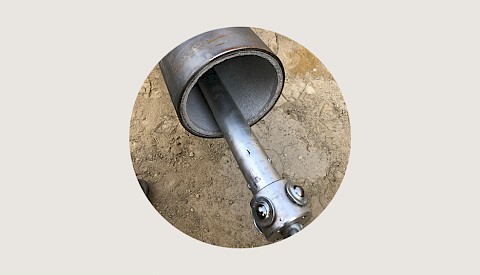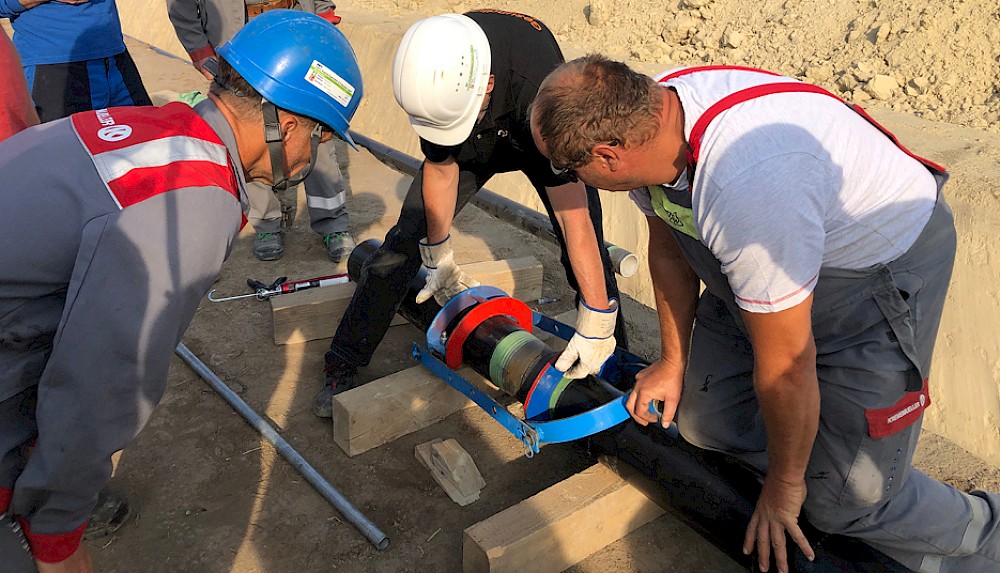Flowlines for OMV in Austria
First choice for secondary recovery
OMV operates its Innovation & Technology Center (ITC) in the heart of one of Europe’s oldest oil production areas, the Austrian Weinviertel region east of Vienna. One of its research focuses is on optimising de-oiling rates by means of secondary oil recovery.
Although domestic oil and gas production in Austria recently accounted for only about 10 per cent of supplies from its own sources, this is still important as an alternative to Russian energy supplies.
In order to further increase the yields of developed oilfields, OMV is conducting in-depth research into the optimisation of secondary oil recovery. In this process, the pressure in the oilfield is maintained by injecting water. This significantly increases an oilfield’s production rates and overall yield.
Technically, this is achieved by using injection lines for water inflow and oil-gathering lines, so-called flowlines, for the pumped medium consisting of an oil-water mixture.
Aggressive production media call for high internal corrosion protection
Since 2020, a project has also been underway in this context to investigate the corrosion resistance of oil-gathering and water injection pipes. This is because the composition and properties of the pumped media change significantly during secondary oil recovery, with the oil-water mixtures showing high mineralisation rates, solids contents and, in some cases, dissolved gases such as hydrogen sulfide and carbon dioxide.
The media pipes must be suitably corrosion-resistant – and that at operating pressures of up to 100 bar.

Lines of pipes without internal corrosion protection would have had to be replaced by now. This in itself is proof of the system’s economic viability.«Dr. Juri Rosen, Product Manager at Mannesmann Line Pipe

Pigging device lance for pipe joints.
Steel beats GRP and stainless steel
The original project planning of the OMV engineers favored the use of non-metal (GRP) and stainless steel pipes and excluded steel pipes.
Fortunately, during a presentation in Gänserndorf in February 2020, Mannesmann Line Pipe employees Thorsten Schmidt, Manuel Müller and Dr Juri Rosen were able to persuade the project managers of the technical and economic merits of HFI-welded steel pipes. They presented a solution with an outer PE coating and inner corrosion protection with a cement mortar lining. “First of all, we were able to refer to a pilot project in which similar pipes had already been in maintenance-free use for nine years,” Rosen recalls, “and then we were able to plausibly demonstrate how the cost in the specific application would be significantly lower than with the pipes so far preferred.” And this at pressure loads of up to 100 bar with simultaneous extreme bending stress, as demonstrated by a study conducted by the University of Siegen.

Pipe puller in action.
Intelligent systems approach
The project engineers were also swayed by the straightforward installation system of pipes with push-in welding sockets, which are first mechanically assembled with little technical effort and only then welded together.
Thanks to the design and connection technology of the push-in sockets, they permit absolutely continuous corrosion protection of the pipe’s inner surface.
Thorough consultation and project support on site
Working with OMV’s engineers, Dr Hans-Jürgen Kocks and Dr Juri Rosen first established the precise technical specifications and defined the production parameters.
Rosen and Müller were then finally on site in September 2021 during the laying of the pipelines to provide advice and assistance to OMV staff. PE-coated push-in welding socket pipes with cement mortar linings based on modified blast furnace cement (Variodur 50) were used.
196 steel pipes measuring 114.3 x 5.0 mm were welded together with 38 DN 100 bends to form a 2.8 km water injection pipeline. The 82 168.3 x 4.5 mm pipes were joined with 19 DN 150 bends to form a 1,200 m oil-gathering pipeline.
After hydraulic testing, which was also assisted by Mannesmann Line Pipe employees, the pipes went straight into operation.
Viability proven in practice
The pipes from Mannesmann Line Pipe have been in continuous maintenance-free operation for two years now. “Lines of pipes without internal corrosion protection would have had to be replaced by now,” Rosen is certain. “This in itself is proof of the system’s economic viability.”
In this respect, he is confident that the system will remain the first choice for secondary oil recovery from now on – and perhaps not only at OMV.

Information on “HFI-welded steel pipes for oil-gathering systems in water-flooded oilfields” can be found here: www.mannesmann-innovations.com
